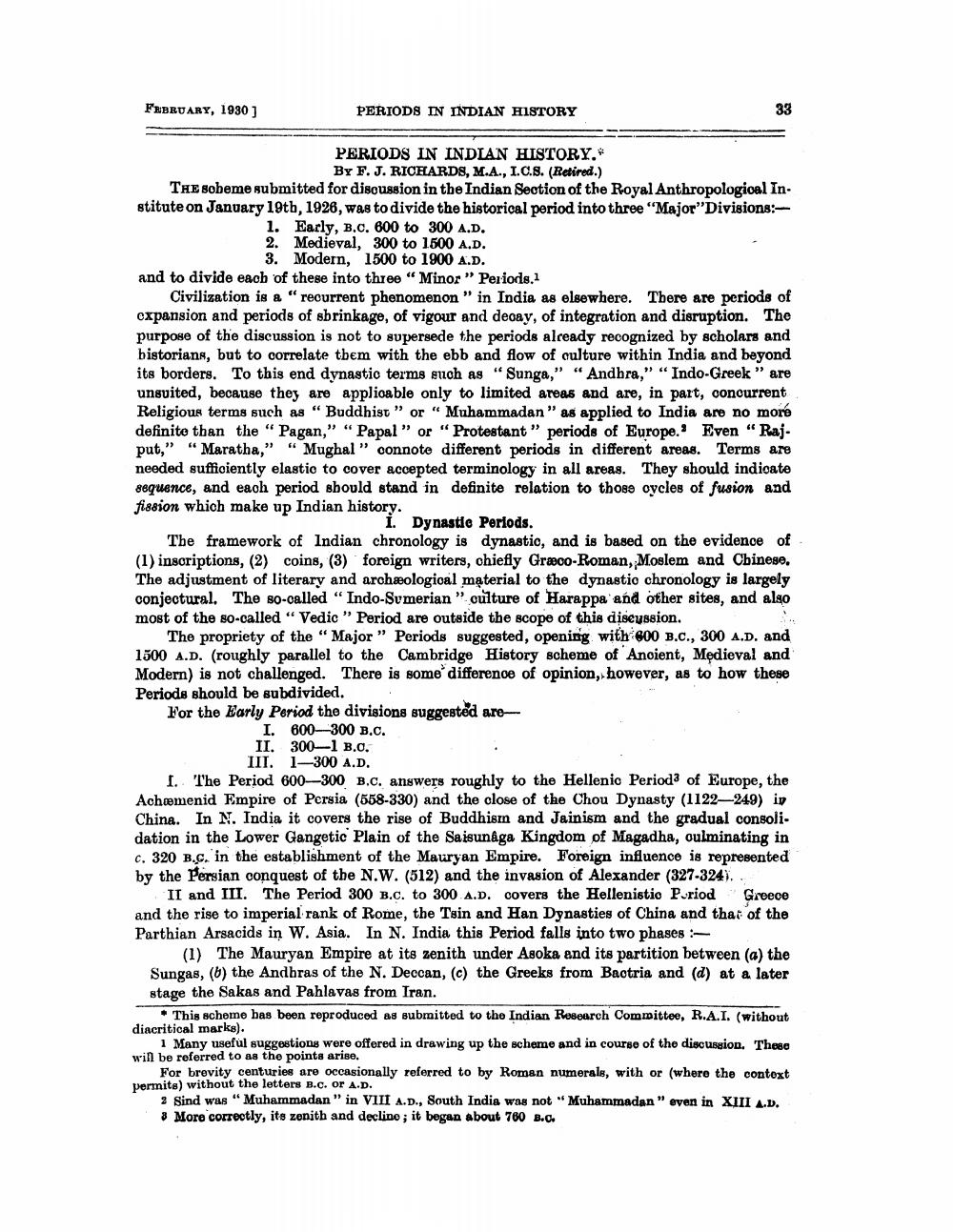________________
FEBRUARY, 1930 ]
PERIODS IN INDIAN HISTORY
33
PERIODS IN INDIAN HISTORY.*
By F. J. RICHARDS, M.A., I.C.S. (Retired.) The sobeme submitted for discussion in the Indian Section of the Royal Anthropologioal In. stitute on January 19th, 1926, was to divide the historical period into three "Major"Divisions:
1. Early, B.C. 600 to 300 A.D. 2. Medieval, 300 to 1500 A.D.
3. Modern, 1500 to 1900 A.D. and to divide each of these into three "Minor "Periods.1
Civilization is a "recurrent phenomenon " in India as elsewhere. There are periods of expansion and periods of sbrinkage, of vigour and decay, of integration and disruption. The purpose of the discussion is not to supersede the periods already recognized by scholars and bistorians, but to correlate them with the ebb and flow of culture within India and beyond its borders. To this end dynastic terms such as "Sunga," "Andhra," "Indo-Greek" are unsuited, because they are applioable only to limited areas and are, in part, concurrent Religious terms such as "Buddhist " or " Muhammadan "as applied to India are no more definite than the "Pagan," " Papal” or “Protestant" periods of Europe. Even "Rajput," "Maratha," "Mughal" connote different periods in different areas. Terms are needed sufficiently elastic to cover accepted terminology in all areas. They should indioate sequence, and each period should stand in definite relation to tho89 oycles of fusion and fission which make up Indian history.
i. Dynastie Periods. The framework of Indian chronology is dynastic, and is based on the evidence of (1) inscriptions, (2) coins, (3) foreign writers, chiefly Græco-Roman, Moslem and Chinese. The adjustment of literary and archæologioal material to the dynastic chronology is largely conjectural. The so-called "Indo-Sumerian "culture of Harappa and other sites, and also most of the 80-called " Vedic "Period are outside the scope of this discussion.
The propriety of the "Major" Periods suggested, opening with 600 B.C., 300 A.D. and 1500 A.D. (roughly parallel to the Cambridge History scheme of Ancient, Medieval and Modern) is not challenged. There is some differenoe of opinion, however, as to how these Periods should be subdivided : For the Early Period the divisions suggested are
I. 600—300 B.C. II. 300—1 B.O.
III. 1-300 A.D. I. The Period 600--300 BC, answers roughly to the Hellenio Period of Europe, the Achæmenid Empire of Persia (558-330) and the close of the Chou Dynasty (1122—249) in China. In N. India it covers the rise of Buddhism and Jainism and the gradual consoli. dation in the Lower Gangetic Plain of the Saisunaga Kingdom of Magadha, oulminating in c. 320 B.C. in the establishment of the Mauryan Empire. Foreign influence is represented by the Persian conquest of the N.W. (512) and the invasion of Alexander (327-324..
II and III. The Period 300 B.C. to 300 A.D. covers the Hellenistio Puriod Greece and the rise to imperial rank of Rome, the Tsin and Han Dynasties of China and that of the Parthian Arsacids in W. Asia. In N. India this Period falls into two phases -
(1) The Mauryan Empire at its zenith under Asoka and its partition between (a) the Sungas, (b) the Andbras of the N. Deccan, (c) the Greeks from Baotria and (d) at a later stage the Sakas and Pahlavas from Iran.
- This scheme has been reproduced as submitted to the Indian Research Committee, R.A.I. (without diacritical marks).
1 Many useful suggestions were offered in drawing up the scheme and in course of the discussion. These will be referred to as the points arise.
For brevity centuries are occasionally referred to by Roman numerals, with or (where the context permits) without the letters B.c. or A.D.
2 Sind was "Muhammadan" in VIII A.D., South India was not "Muhammadan" even in XIII A.D. 3 More correctly, its zenith and decline ; it began about 780 B.C.




